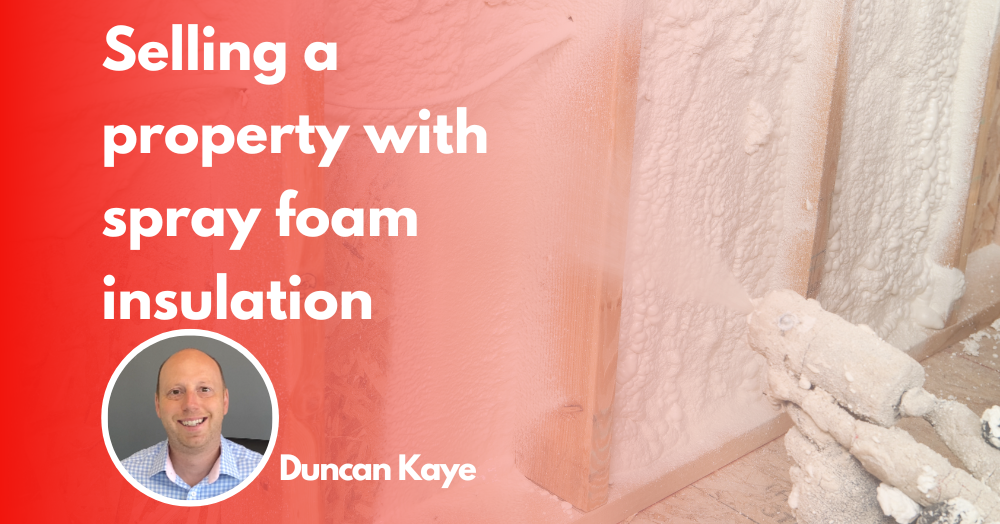
The Challenges of Selling a Property with Spray Foam Insulation in the UK
While spray foam insulation offers excellent energy efficiency and thermal benefits, it can complicate the property sale process. This article explores the types of spray foam insulation, the reasons behind the difficulties in securing a mortgage, and the impact on selling properties
Selling a property in the UK can present various challenges, and one increasingly common issue is the presence of spray foam insulation in the roof.
Types of Spray Foam Insulation
Spray foam insulation is broadly categorised into two types: open-cell and closed-cell foam.
- Open-Cell Foam: This type of foam is less dense, allowing air and moisture to pass through it. It is typically used for interior applications where air circulation is not a concern. Open-cell foam is soft and flexible, providing good soundproofing but less structural support compared to closed-cell foam.
- Closed-Cell Foam: This foam is denser and more rigid, creating an airtight seal that prevents air and moisture from penetrating. Closed-cell foam is often used in exterior applications and areas where moisture resistance and additional structural support are required. It offers better insulation properties but is more expensive than open-cell foam.
Challenges with Spray Foam Insulation
The primary issues with spray foam insulation, particularly in the loft, arise from concerns related to moisture, structural integrity, and ventilation. These concerns can significantly impact the property's marketability and mortgage eligibility.
- Moisture and Ventilation Concerns: Closed-cell spray foam can create a barrier that traps moisture within the roof structure. This can lead to condensation and, over time, cause timber rot or mold growth. Proper ventilation is crucial in loft spaces to prevent moisture build-up, and the impermeable nature of closed-cell foam can hinder this.
- Structural Integrity: Inspecting the condition of roof timbers is essential for assessing a property's structural integrity. Spray foam, particularly closed-cell foam, can obscure the view of roof timbers, making it difficult for surveyors to detect potential issues like rot or infestation. This lack of visibility raises concerns for lenders and surveyors.
- Removal and Remediation Costs: If spray foam insulation is found to be problematic, removing it can be costly and time-consuming. The process involves stripping out the foam and potentially replacing damaged roof materials, which can be a significant expense for sellers and a deterrent for buyers.
Mortgage Difficulties
One of the most significant hurdles in selling a property with spray foam insulation is obtaining a mortgage. Lenders and surveyors often view spray foam insulation, especially closed-cell foam, as a risk for several reasons:
- Inspection Challenges: The inability to properly inspect roof timbers due to the presence of spray foam raises red flags for lenders. They need to ensure the property is structurally sound and free from hidden damage.
- Potential for Future Issues: The risks associated with moisture build-up and timber degradation can lead to future repair costs, which lenders want to avoid. The potential for these issues makes properties with spray foam insulation less attractive for mortgage approval.
- Devaluation: Properties with spray foam insulation may be devalued due to the perceived risks and potential repair costs. This devaluation can affect the loan-to-value ratio, making it harder for buyers to secure a mortgage with favorable terms.
Conclusion
While spray foam insulation can provide excellent thermal performance and energy savings, it can complicate the property sale process. The challenges associated with moisture management, structural inspection, and mortgage approval make it essential for sellers to address these issues proactively.
Consulting with a qualified surveyor, ensuring proper ventilation, and being transparent with potential buyers about the insulation can help mitigate some of these challenges.
As always, if you have any questions or if you’d like some general advice about the Romford property market, get in touch using the details below.
Make sure you follow Keys & Lee on Instagram, Facebook and YouTube for regular content and information for homebuyers and sellers in Romford.
07969 638349
duncan.kaye@keysandlee.co.uk

